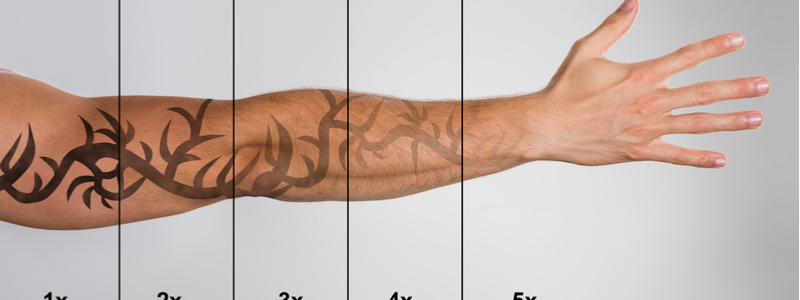How Does Laser Tattoo Removal Work

One in four Americans have at least one tattoo, and one in four of them have tattoo regret. The reasons range from a change in lifestyle, taste, or fashion. Some no longer want a tattoo and others want them removed so that they can get a different tattoo.
Methods used to remove tattoos such as dermabrasion, scarification, and cryosurgery don't actually remove the tattoo but cover it up with scar tissue. These factors have all combined to make laser tattoo removal more popular.
If you're interested, but perhaps a little skeptical, understanding how laser tattoo removal works can help you decide if this is something that might work for you.
What to Expect during Laser Tattoo Removal
How long it will take for your tattoo to be removed depends on where the tattoo is located, what color inks were used, and how old the tattoo is. Removing some tattoos can take a year or more to be removed. In general, the tattoo is not completely removed in one session.
During laser tattoo removal a specific laser handpiece is used to break up the ink particles, making them smaller and easier for the body's lymphatic system to remove them. Tattoo removal lasers operate at high temperatures on a very narrow frequency and are extremely fast. They work on a scale of picoseconds, which is one trillionth of a second. This heat and speed is the crucial element in breaking the ink particles apart.
The ink particles expand when heated, but the zap is quick enough that only half the particle is heated. The opposing hot and cool forces cause the particles to split apart.
Effect of Location on Tattoo Removal
Once you have decided to have laser tattoo removal, the doctor or dermatologist will use a laser to send energy into your skin to break up the ink molecules that make up the tattoo. The lymphatic system absorbs the smaller ink molecules and removes them from the body, a process that takes about 4-6 weeks. Since the body can only remove a finite amount of ink molecules at a time, it usually takes many sessions to completely remove the tattoo.
Because the bloodstream carries the ink particles to the lymphatic system for removal, and the closer the tattoo is to the heart, the faster the ink particles are removed and the faster the tattoo will be removed. Tattoos on the feet and hands take longer than tattoos closer to your core, and leg tattoos often require more sessions.
Effect of Color on Tattoo Removal
The color of ink used in tattoos also affects their removal. The color of the ink used makes a difference in the hand pieces and settings used for removal. For example, all-black tattoos need one adapter, and often are removed faster than other colors. Tattoos with colors are treated in stages, because each color may require a different adapter.
Usually the black ink on the tattoo will be treated first, then the laser is adjusted so the red and yellow inks can be treated. Lastly, the greens and blues will be treated. This requires protective eyewear and a different handpiece. Greens and blues are more likely to cause blistering, but this generally subsides in 24-48 hours.
Effect of a Tattoo's Age on Removal
Tattoos fade over time. This is because the cells injected with ink deep within the skin are in a constant renewal process. Old skin cells that contain tattoo ink die and are replaced with healthy, new, un-inked cells. Fading will make the tattoo removal process go faster. A 10-year-old, solid black tattoo may take 7-10 treatment sessions, while a newer, multi-colored tattoo may take up to 12 sessions.
Does Laser Tattoo Removal Hurt?
The pain of laser tattoo removal has been compared to that of a rubber band snapping on the skin. Some have said it is about the same as actually getting a tattoo. You can choose to squeeze a stress ball or practice deep breathing to distract yourself from the pain. You can also request to have a lidocaine-based cream applied to take the edge off the pain. You can also request a break if the pain becomes too intense.
Although occasionally some people have adverse reactions to laser tattoo removal treatments such as extreme blistering and hypopigmentation, most people tolerate the treatments very well. There are many factors at play, including skin tone, age of tattoo, where it's located, the type of laser treatment used, and even your general health. A skilled doctor with state-of-the-art equipment and treatments scheduled every 4-6 weeks can result in smooth and unblemished skin where the tattoo used to be.
Thanks for sharing your experience! Laser tattoo removal can be uncomfortable, but pain levels vary from person to person. Many describe the sensation as similar to snapping a rubber band against the skin. Some areas of the body are more sensitive, which can make the process feel more painful. You can find more information about this here https://renudelaser.com.au/laser-tattoo-removal-hurt/ . Clinics often use numbing creams or cooling devices to help reduce discomfort during treatment. Overall, while it’s not completely painless, most people find it manageable.